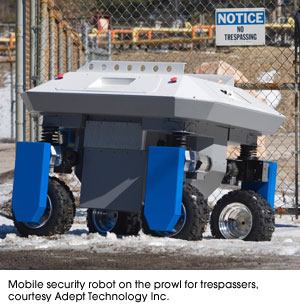Robotics Online
Nov 14, 2011
Robotics have been a staple of advanced manufacturing for over half a century. As robots and their peripheral equipment become more sophisticated, reliable and miniaturized, these systems are increasingly being utilized for military and law enforcement purposes.
“Military and battlefield applications continue to grow at an accelerated pace due to demand fueled by government investment. Over the past decade, we have seen increasing levels of investment in autonomous vehicles used for surveillance and security,” says Rush LaSelle, Vice President and General Manager with Adept Technology Inc. (Pleasanton, California) “Applications range from monitoring perimeters of secured areas such as airports to acting as a night watchman.”
Robots go to War
Mobile robotics play an increasingly important role in military matters, from patrol to dealing with potential explosives. “With suitable sensors and cameras to perform different missions, mobile robots are operated remotely for reconnaissance patrol and relay back video images to an operator,” says Dr. Andrew Goldenberg, PhD, Chief Executive Officer and President of Engineering Services Inc. (ESI, Toronto Ontario, Canada) “Robots can neutralize suspicious objects that may explode. The platform has a robot arm to pick up explosives or suspected hazards in military or civilian settings.”
Goldenberg goes on to say, “The mobile robotic platform is mounted on a rectangular box with electronic equipment. The platform moves on wheels or tracks, or both, and is usually battery-powered. Communication equipment and sensors can detect images, sounds, gases and other hazards. The communication systems read sensors and relay that information to the operator.”
According to Goldenberg, the United States military recently began equipping mobile robotic platforms to carry small and medium-size firearms.
Robotics help meet challenges posed by the specter of urban terrorism. “Instead of having people get close to hazards such as unattended objects or car bombs, robots are used. If an operator concludes a dangerous object might explode, the robot could neutralize that object by shooting to detonate it,” Goldenberg says. “Mobile robots detect and explode in-ground mines or improvised explosive devices.” These same mobile robotic systems are used for neutralizing or exploding forgotten ordnance and mines after conflicts cease.
Likewise, LaSelle says, “Government acts as a catalyst for these applications due to the heavy investment after the terrorist attacks of September 11, 2001. Security and patrol functionalities have extended into the private sector. Companies invest in autonomous vehicles to monitor warehouses, factories, and office spaces. These sentinel applications provide users with the ability to monitor a variety of conditions such as motion, intrusion, water ingress, and temperature.”
Keeping tabs on temperature is of special importance to server farms and other sensitive electronic systems, LaSelle says. “A key area of activity for mobile robotic platforms is patrolling vacant properties and warehouses due to the reliability and low costs attributed to autonomous vehicles,” adds LaSelle.
Goldenberg’s and LaSelle’s portrayals of tasks carried out by mobile robotic platforms is echoed by Sean Thompson, Applications Engineer with MICROMO. (Clearwater, Florida) “Ground-based systems use robotics for surveillance. These platforms are equipped with weapons and cameras.” Thompson dubs some reconnaissance robots as “throw-bots,” saying these systems are “Small and light robots, robust enough to throw through a window or doorway. The robot is equipped with a camera to see within a building without sending in people.” If the structure is without light, the mobile platform’s camera is equipped with infrared or night vision, Thompson says. Another less conventional robotic application is a small reconnaissance aircraft transported by backpack. “A soldier throws small reconnaissance aircraft into the air which takes off and recover themselves.”
Additionally, Thompson says mobile robotics assist military personnel transport equipment in the field. “In military applications, wearable robotics help soldiers carry a heavy pack load. A robot acts like a pack mule, is fully autonomous, and carries a large amount of supplies.”
Thompson speaks of robotics to help inspect and maintain nuclear weapons. “Mobile robotic systems inspect nuclear missiles. Commonly, such inspection systems were large, requiring several people in protective suits going into containment systems. Now, smaller self-guided robotic systems require only one person in a protective suit going to a certain point and letting the robot go.” The robot is remotely operated outside the containment system, reducing the number of people and the amount of time people are exposed to relatively high radiation levels, Thompson concludes.
To read more click here...

0 comments:
Post a Comment